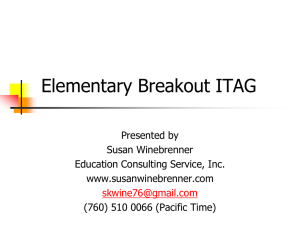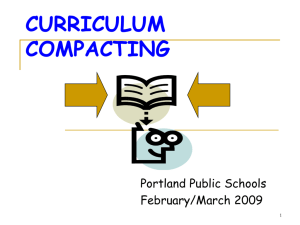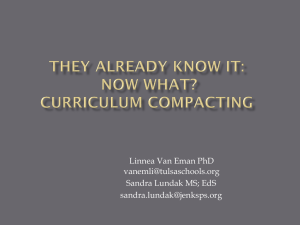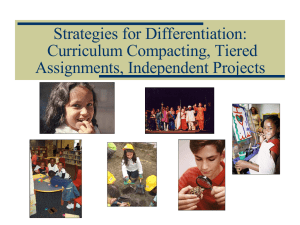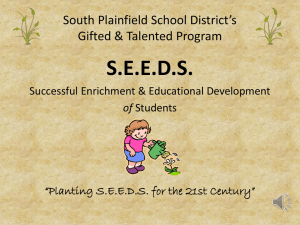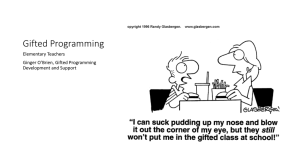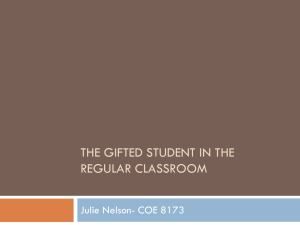PPT Slides
advertisement
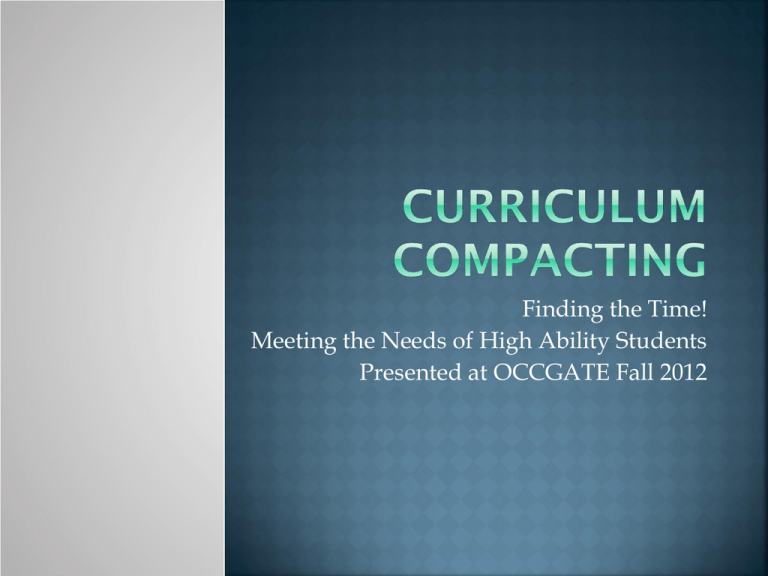
Finding the Time! Meeting the Needs of High Ability Students Presented at OCCGATE Fall 2012 Curriculum compacting is a procedure used to streamline the regular curriculum for students who are capable of mastering it at a faster pace. The compacting process has three basic phases: Determine the goals and objectives of the regular curriculum. Assess students for previous mastery of these objectives. Substitute more appropriate (challenging) options. Students already know most of their text’s content before “learning it”. Taylor and Frye (1988) found that 78-88% of fifth and sixth-grade average readers could pass pretests on basal comprehension skills. Flanders (1987) found that students in grades two to five encounter approximately 40-65% new content. Textbooks have been “dumbed down”. Decreased vocabulary Simplification of vocabulary Narrowed range of reading ability Sentence structure simplified Adjectives and other describers are limited The quality of textbooks has failed to improve. A Nation at Risk (1983) recommended that (textbooks) and other tools of learning and teaching be upgraded to assure more rigorous content. Chall and Conrad (1991) indicate that readability levels did not change in any appreciable way. Tyson-Berstein (1988) state “editors are increasingly organizing elementary reading series around the content and timing of standardized tests.” The needs of high-ability students are not often met in classrooms. The National Research Center on the Gifted and Talented – “The Classroom Practices Observation Study” (1992) Little differentiation in instructional and curricular practices including grouping arrangements and verbal interactions. Gifted students received homogenous grouping only 21% of the time. GATE or high-ability students experienced no instructional or curricular differentiation in 84% of the instructional activities in which they participated. Compacting provides time for more challenging learning experiences. Pursuit of independent studies Reading self-selected materials Other replacement options The pace of instruction and practice time can be modified. Elementary classroom teachers can eliminate as much as 40-50% of the basal regular curriculum for high-ability students. For gifted learners, that percentage may be as high as 70-80%. Middle school students can compact out up to 50% of core curriculum. Compacting guarantees educational accountability. Not all high-ability and gifted learners will know it all. When compacting curriculum, teachers can document the student’s strengths and teach missed concepts commensurate with student ability. Identify the relevant learning objectives in a given subject area or grade level. California Department of Education – Grade Level Standards Common Core Standards District pacing guides Teacher’s manuals Curriculum specialists Find or develop some means of pretesting students on one or more of these objectives prior to instruction. District assessments Adopted curriculum assessments Chapter tests Unit tests Beginning of the Year/End of Year assessments OARS – Online Assessment Reporting System Identify students who may benefit from curriculum compacting and should be pretested. GATE identification list GATE folder list/merit list STAR data Teacher recommendation Pretest students to determine their mastery levels of the chosen objectives. Determine as a grade level or site what constitutes mastery. Determine what students will participate in extension activities or enrichment projects. Determine what students need to have small group instruction for missed concept(s). Eliminate practice, drill, or instructional time for students who have demonstrated prior mastery of these objectives. Students “buy time” to work on extension activity or enrichment project. Differentiate assignments based on student need. Streamline instruction of those objectives students have not yet mastered but are capable of mastering more quickly than their classmates. Small group instruction Practice worksheets Computer software/on-line resources Cooperative learning Peer tutoring Offer enrichment or acceleration options for students whose curriculum has been compacted. Classroom Independent or small group study Escalated coverage of curriculum Special interest groups Activities: “Interest-A-Lyzer” – Joe Renzulli “My Way” – Joe Renzulli “If I Ran the School” – Sally Reis and Del Siegle Lessons to further cognitive and affective processes Schoolwide Enrichment Model (SEM) – Type II Process Skills Keep records of this process and the instructional options available to “compacted” students. Personalized Education Plan (PEP) Report card “The Compactor” – Individual Educational Programming Guide Start small – choose a small group of students for whom compacting would be appropriate. Select one area – choose one curricular area in which the targeted group has shown considerable mastery and that you have appropriate enrichment materials. Experiment with pretesting – find a method compatible with the curriculum, the students, and you. Compact by topic – compact for a unit, chapter, or topic rather than a grading period. Decide how to document – determine at the site how a child’s progress will be documented and define proficiency based on site consensus and district policy. Find a wide variety of alternatives – find and create a wide range of enrichment opportunities to replace content that will be eliminated through compacting. Keep experimenting – try new ideas, reflect upon success, and modify as needed. Comic Book Bridge Curriculum Compacting: The Complete Guide to Modifying the Regular Curriculum for High Ability Students Sally Reis, Deborah Burns, Joseph Renzulli Independent Study Sandra Kapan and Bette Gould The Parallel Curriculum: A Design to Develop Learner Potential and Challenge Advanced Learners Carol Ann Tomlinson, Sandra Kaplan, Joseph Renzulli, Jeanne Purcell, Jann Leppien, Deborah Burns, Cindy Strickland, Marcia Imbeau Type www.gifted.uconn.edu/sem/typeiips.html My Way (Expression Style Inventory) www.gifted.uconn.edu/sem/pdf/myway.pdf The II Processing Skills Compactor (Documentation of Services) www.gifted.uconn.edu/siegle/curriculumcompa cting/SEC-IMAG/compactor.pdf Interest-a-lyzer (Small group or independent project survey – upper elementary) http://enrichmenttriadmodel.weebly.com/uploa ds/7/6/4/7/7647438/the_interest-a-lyzer.pdf If I Ran the School (Small group or independent project survey – primary) http://www.gifted.uconn.edu/siegle/curriculum compacting/SEC-IMAG/ranschol.pdf Krisa Muller Woodsboro Elementary Placentia-Yorba Linda School District kmuller@pylusd.org
